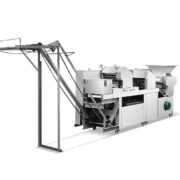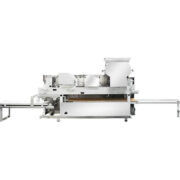Industrial Noodle Machine
Main Benefits
- Fit for many kinds of noodle such as fresh&dry noodle making
- Noodle width can be customized 1.5/2/3/4mm available
- Noodle thickness can be adjustable on roller part
- Fully stainless steel ensure hygienic manufacture
- One-touch waterproof switch, easy operation
- Small investment and floor space required
- Can be operated by single person
- Stable performance, high efficiency
Overview
Introducing our revolutionary noodle making machine, designed to cater to the needs of food enthusiasts who crave delicious homemade noodles. With the emergence of this innovative appliance, the process of noodle preparation is now more convenient than ever before. Operating on a simple principle, the machine utilizes the relative rotation of the dough rollers to squeeze the flour, forming dough sheets that are subsequently cut into strips by the front noodle cutting knife, resulting in perfectly shaped noodles. The versatility of this machine lies in its ability to accommodate different specifications of noodle cutters, allowing for the production of noodles in various shapes and sizes. The surface of the rollers has been meticulously ground to ensure a smooth and visually appealing finish, resulting in uniformly rolled noodle strips of exceptional quality.
Our noodle machine boasts a well-thought-out design, incorporating an array type, reducer, and sprocket transmission that not only minimizes noise but also provides a compact structure. With its humanized design, the machine effortlessly reduces labor requirements, making it a user-friendly option. The ease of operation, coupled with its safety and hygienic features, ensures a seamless noodle-making experience. The smooth transmission system guarantees accurate and efficient power delivery, while maintaining low noise levels and vibration-free performance. We have further enhanced the machine by equipping it with an automatic cutting function, enabling users to achieve precise and consistent noodle lengths. This eliminates the need for manual weighing and cutting, improving both efficiency and hygiene standards. Our fully automatic noodle machine represents the perfect amalgamation of traditional craftsmanship and modern technology, resulting in an advanced structure, exceptional performance, and an aesthetically pleasing appearance. It is a labor-saving solution suitable for a range of establishments, including hotels, restaurants, food processing factories, canteens, and even individual production.
Videos
Features
- Convenient self-removable noodle making mold for easy cleaning.
- Heightened protective copper double scraper for enhanced durability.
- Intelligent adjustment of dough thickness with variable frequency speed regulation.
- Easy dough thickness adjustment with hand wheel adjustment lever.
- User-friendly operation with humanized design adjustment knob.
- Insulating material power switch, waterproof, dirt-proof, and easy to use.
- Large roller diameter with high rolling ratio, strength, and hardness.
- High-quality customizable noodle knives available in various sizes.
- Consistent results with continuous appearances without adhesion.
- Hygienic and durable food-grade stainless steel roller.
- Automatic dough feeding with five sets of pressure rollers for even thickness.
- Easy dough pressing of different thicknesses with clamp-type adjustment handle.
- Double-scale precise adjustment for controlling noodle thickness.
- Various roller lengths available or customized
- Compatible with lifting and noodle machines for versatile usage.
- Forms an automated noodle production line with dough mixer, dryer, steamer, etc.
Specifications
| Model | Capacity(Kg/h) | Power(Kw) | Roller Size(mm) | Weight(Kg) | Machine Dimension(mm) |
| NM5-200 | 150-170 | 3.0 | φ96X250 | 380 | 1600X570X1225 |
| NM5-250 | 170-200 | 3.0 | φ140X260 | 510 | 1800X580X1250 |
| NM5-300 | 200-230 | 3.0 | φ140X300 | 580 | 1800x630x1370 |
| NM6-250 | 180-210 | 4.0 | Φ96X250 | 520 | 2000X650X1250 |
| NM6-260 | 240-260 | 4.0 | φ140X260 | 620 | 2300X600X1370 |
| NM6-300 | 240-280 | 4.0 | φ140X300 | 820 | 2300X650X1370 |
| NM6-330 | 280-300 | 4.0 | φ140X330 | 980 | 2300X633X1370 |
| NM6-360 | 260-330 | 5.5 | φ140X360 | 960 | 2300X660X1370 |
| NM7-300 | 260-300 | 5.5 | Φ140X300 | 1000 | 3400X720X1350 |
| NM7-330 | 280-320 | 5.5 | φ140X330 | 1200 | 3000X680X1420 |
| NM7-360 | 360-600 | 5.5 | φ140X360 | 1350 | 3000X760X1500 |
FAQ
How to Install an industrial noodle machine?
-The industrial noodle machine must be installed on a dry and well-ventilated surface to ensure smooth and reliable operation.
-Before use, verify if the power supply voltage is compatible with the Chinese noodle machine and ensure that the wire core with the grounding symbol is securely grounded.
-Adjust the roller gap from thick to thin when kneading and pressing the dough, with the incoming surface thickness being 2-3 times that of the outgoing surface.
-Install the noodle cutter by placing it into one of the two cutter grooves on the left and right grid plates. Engage the upper gear with the large gear, tighten the nut, and use the fixing bracket to secure the noodle cutter in place.
-Manually insert the end of the dough sheet between the two rolling rolls. After rolling, guide the dough into the dough cutter to cut out the noodles, which will then land on the conveyor belt.
How to operate the industrial noodle machine?
Step 1: Preparation
Prior to commencing the operation of the machine, ensure that all the necessary ingredients for noodle production are readily available. These typically include flour, water, and any additional flavors or seasonings. Furthermore, it is essential to ascertain that the machine is thoroughly cleaned and devoid of any debris.
Step 2: Mixing the Ingredients
The subsequent step involves depositing the aforementioned ingredients into a mixer machine. Vigorously combine the flour and water to form a cohesive dough. The dough mixer comprises various components such as a mixing tank, a stirring hook, a transmission device, an electrical box, and a machine base.
Step 3: Dough Pressing
Distinct noodle machines possess varying quantities of noodle-pressing rollers. The roll-formed dough is uniformly thick and can be adjusted according to the preferences of the customer. This industrial equipment exhibits a substantial capacity.
Step 4: Noodle Cutting
The automatic noodle machine’s cutter efficiently slices the dough sheet into noodles of identical dimensions. The process involves automatic conveyance, segmentation, and placement onto a pole, ultimately resulting in a cohesive formation. The cutter can be substituted to produce noodles of varying thicknesses.
What precautions should be taken when using the industrial noodle machine?
-Ensure that the mixing ratio of noodles and water is 10:3.
-Begin by adjusting the dough roller to the widest position and flatten the dough to approximately 4-5 mm thickness. It can be double-layer pressed from left to right.
-After repeated flattening and smoothing, allow the dough to rest. Adjust the dough roller to about 3 mm and press the dough once.
-Install the top knife and adjust the gap between the top rollers to approximately 2 mm.
-When pressing out the noodles, make sure to sprinkle a small amount of dry flour to prevent the soft noodles from sticking together.
What is the common faults and solutions of industrial noodle machine?
Button malfunction: If the operating button of the noodle machine is not functioning properly or is unresponsive, you should check for any looseness or debris in the button area. In such cases, it is necessary to clean the affected area and fix the buttons.
Noodles not pulling smoothly: If you experience a stuck feeling while pulling noodles, it might be due to dough or noodles getting stuck inside the machine. To resolve this issue, you can disassemble the machine, clean the area where the noodles are stuck, and apply an appropriate amount of vegetable oil or edible oil to prevent adhesion.
Abnormal sound: If you hear any unusual sounds while using the noodle machine, it is likely that a certain part is damaged or loose. Check if all components are properly installed. If the problem persists, contact the manufacturer for repair.
Sticky noodles: When using a noodle press to make noodles, if you notice that the noodles are too sticky, it could be because the equipment has not been cleaned thoroughly or maintained regularly. It is recommended to clean the equipment regularly and change the oil to ensure cleanliness and optimal working efficiency.
How to troubleshoot if the industrial noodle machine is not functioning properly?
Check the power supply:
If the pasta maker is not moving, the first step is to check the power supply. Ensure that the power socket is properly connected and try using a different power cord. If the issue persists, use a multimeter to check for any damage or short circuits on the circuit board or wiring.
Unblock the machine:
If the power supply is not the problem, the noodle maker may be blocked. In such cases, disconnect the main body of the machine from the power source, remove the removable parts, and clean them thoroughly. Make sure there are no blockages or damages. Pay special attention to the mold part, as it often gets stuck with residual dough and flour. If there are any parts that cannot be removed, it is recommended to use professional cleaning fluid after disassembling.
Motor issues:
If none of the above steps resolve the issue, there may be a problem with the motor, and it might need to be replaced. Before replacing the motor, manually rotate it a few times to check for any looseness or sticking. If there is severe looseness or jamming, the motor should be replaced.
Summary:
There are multiple solutions for a non-functioning noodle maker, but always remember to unplug the power cord before performing any maintenance tasks for safety purposes. If none of the above troubleshooting methods work, it is recommended to seek professional after-sales service or consider replacing the noodle machine.
What are the special precautions when using a industrial noodle machine?
-Familiarize yourself with the instructions before using the machine and strictly follow them during operation.
-Do not reverse the machine under any circumstances.
-Before starting the machine, carefully inspect all parts for any abnormalities. If any issues are found, address them promptly to prevent accidents.
-Avoid adding iron or other hard objects into the flour to prevent accidents.
-Do not pour the noodles directly into the noodle bucket.
-While the machine is running, never put your hands near dangerous parts such as rollers, gears, chains, or cutters.
-Ensure that all rotating parts, including the oil mark, inside the oil cup, gears, and chain, are properly lubricated.
-To lubricate the machine, add 20#-30# engine oil twice per shift to the oil hole. Additionally, apply a small amount of cooking oil to the cutter surface and roller surface after each shift.
-The clutch of the rolling, cutting, and mixing noodle machine must be in the stopped state.
-Allow the rolling mill to run idly for 10-15 minutes before starting production. In winter, maintain a temperature of at least 10-15 degrees Celsius in the production room.
-Clean the machine thoroughly after shutting it down. Ensure there is no residue or dough left on each roll.
-Keep all gears and rolling bearings properly lubricated.
-Prevent any hard debris from falling into the rollers and gears.
-Replace the bearing grease every six months.
-It is strictly prohibited to adjust the surface roller gap to more than 5 mm during operation.
-The noodle picker is an accessory for the noodle machine. It is used to place the cut and shaped noodles on the upper pole and hang them in the space.











